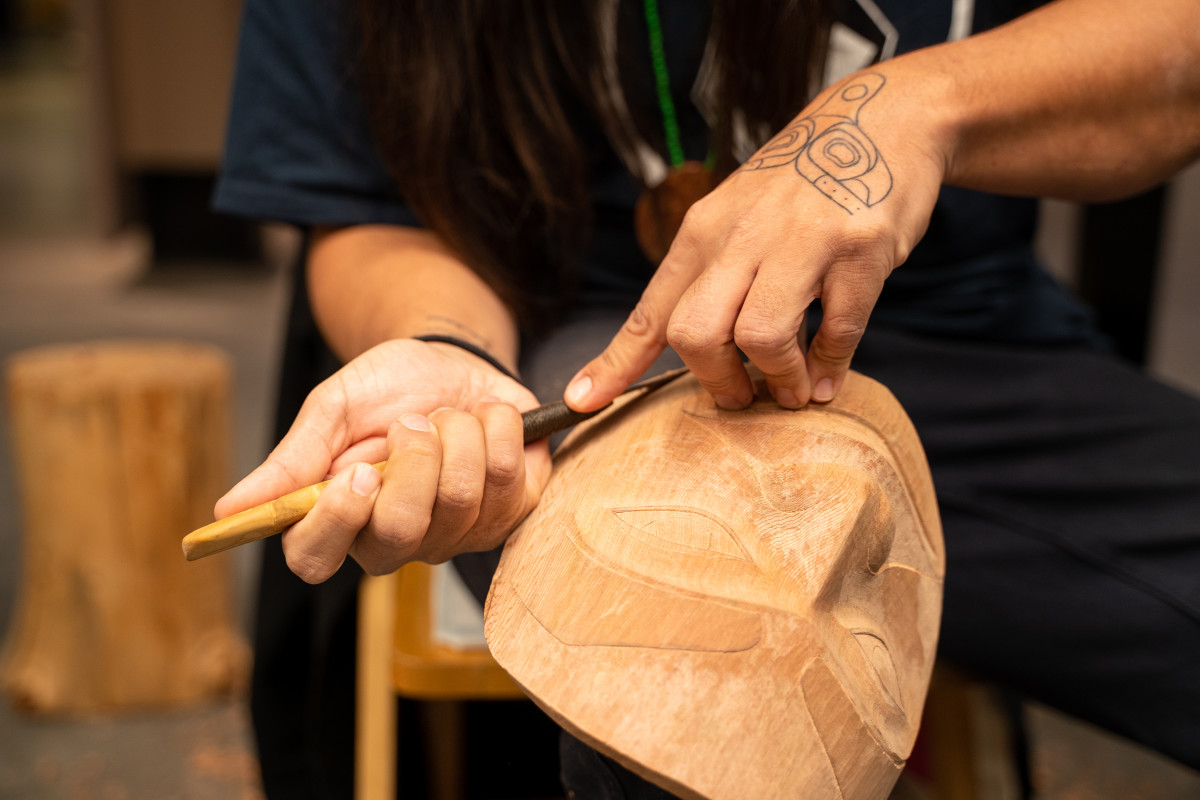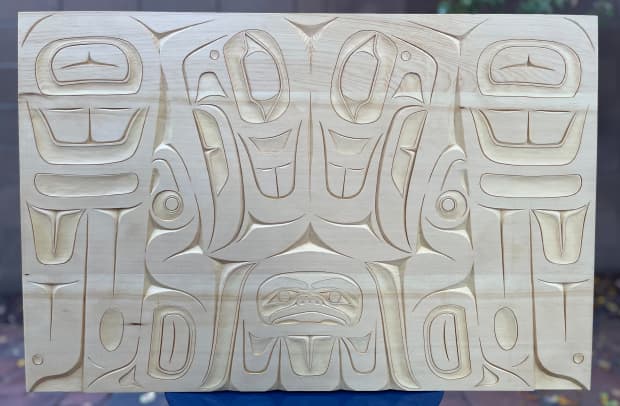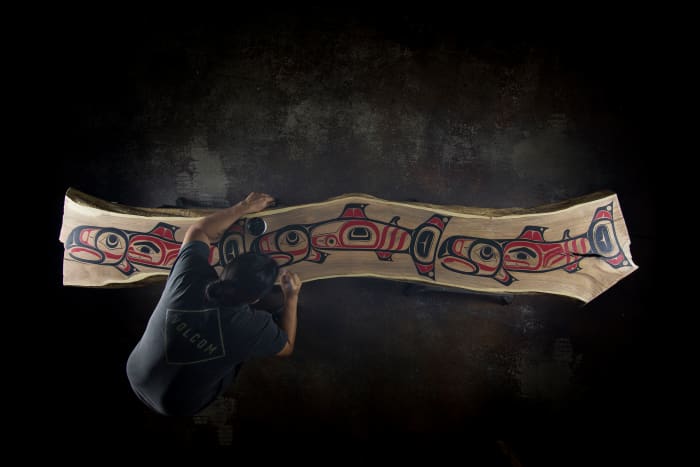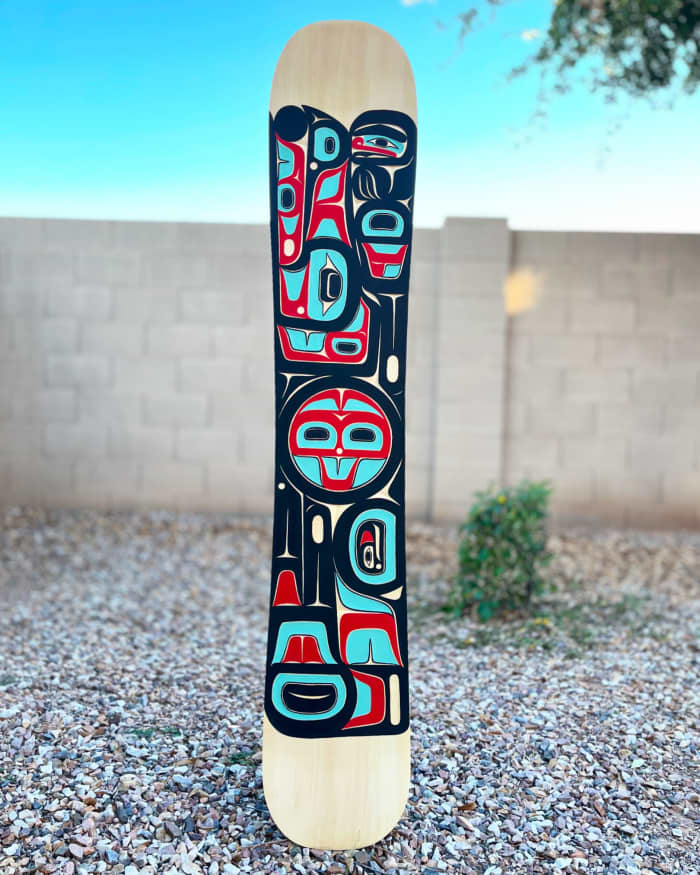Growing up in Juneau, Alaska, Tlingit artist James Johnson uses his art as a means to connect with his cultural heritage, while combating the effects of colonization. As a self-taught artist, he is dedicated to perpetuating the Tlingit art form. You’ve seen Johnson’s work show up in snowboarding through Lib Tech graphics, a Vans Snow collection, Bent Metal bindings, and collaborations with Smartwool, Slowtide, and Natural Selection, on top of countless gallery shows and exhibitions. Much of his art begins as wood carvings, honoring Tlingit tradition and continuing cultural practices that have been obstructed in the face of colonialism. Johnson grew up riding Eaglecrest in Juneau with Mark Landvik, and says that the flow and connection he experiences when making art is similar to how he feels on the mountain. His commitment to carrying on traditional Tlingit art, stories, and knowledge has become his life’s work and allows Tlingit culture to be recognized globally. We caught up with James on his practice, and what we can expect from him in what seems like an incredibly busy year ahead.- Ally Watson
Hometown: I am Tlingit Indian from Southeast Alaska. I belong to the Dakl’aweidi Clan (killer whale). I was born and raised in Juneau, AK.
Home mountain: Eaglecrest in Juneau, AK will always be my home mountain on Tlingit Aani (our land).
Instagram: @jamesjohnsonnativeart
Preferred medium?
The Tlingit art form goes back 10,000 years in Alaska, our traditional medium is wood carving. My ancestors were incredible carvers and sculptures. To be a Tlingit artist, you have to be skilled in a large range of mediums from carving cedar, stone, dall sheep horn, mountain goat horn, to painting, drawing, etc. I work in all of it.
Favorite subject matter?
There is no word for “art” in our language. The pieces you create are a visual language representing the history of the Tlingit people going back thousands of years. These stories and history can be told through any piece; a mask, a rattle, a bentwood box, a totem pole are all containers of knowledge for our people. I am carrying this culture and tradition forward through my work.
Incredible. What is your primary process?
I’ve dedicated my life to the Tlingit art form. It’s not a hobby you do on the weekends. It takes everything you have. All your energy and time are dedicated to this process. The art form is extremely difficult—it’s supposed to be. In the old days, you were known as a carver for your clan and you were really highly regarded among your people. The skill you need to carve these pieces takes years of understanding composition and balance of forms. The foundation is drawing. You need to understand what we call “formline”—the visual imagery you see within the art form. The better you are at drawing, the better carver you’ll be. It teaches you to see the balance. It takes years of drawing and drawing—you have to draw like your life depends on it. That is the starting point before you can even begin to carve.
What is your main source of inspiration?
The work of my ancestors set an extremely high standard for what all Tlingit artists are striving for today. Everyone will tell you we are not at their level yet. We have every tool imaginable to create the art, but the reason why their work is so much better than ours is they had this tremendous knowledge we don’t have today. From colonization of our people in Alaska, coupled with disease, so much of this knowledge was lost. It was severed. Three quarters of the Northwest Coast population died from smallpox. How many artists died before they would pass on the knowledge they had? The remaining children were then sent to residential schools where they were completely stripped of their culture. It was complete cultural assimilation. So, today, as a Tlingit artist, you have such a larger responsibility on your shoulders than just trying to create something that is beautiful. You are carrying forward this tradition, our culture, the history of our people, where everything that could have been done was done to destroy it. Most people are searching for their purpose in life, what they are meant to be doing with their time everyday. This is exactly what I’m meant to be doing. Whether I chose it or it chose me, this is it.
What is your workspace like?
Simple. A piece starts off as a block of wood. You use your adze to shape the piece. This is our traditional tool our people have used for generations. To shape a piece, you need to remove the wood to reveal what is inside. It took me a lot of years to develop this skill, but you can “see” the piece within the wood before you even start. You do adze work on a block of wood as your work station, so the adze blade runout can hit the wood. My dad, who first encouraged me to get into carving, he’d send me big, 300-pound cedar logs. He sent me three of them. I carved all of it learning the proper technique of shaping wood. He’s passed on now, but I kept the last quarter. That is what I sit on when shaping. Then proper finish work on a mask, box, or panel, I do that work at a nice desk with good lighting. I paint all the Lib Tech graphics on canvas as well. Hand painted—nothing is made digitally. Pete Saari from Lib Tech has a lot of the original paintings and carvings I’ve done for the graphics. But, to do proper finish work, you need to slow your mind down. What makes any piece from just good to something extraordinary is how much you put into the finish work.
How do you manage creating and riding with such an in-depth process?
I love snowboarding. I grew up riding in Alaska, and you realize how special of a place it is when you get older. Our Tlingit values give respect to all things; humans, animals, glaciers, ocean, the mountains are all alive, because they contain spirit. All exist on the same plane. What I love about art and snowboarding is that both are mindless. You create your best art when you’re present, as you ride your best when you’re not overthinking it, letting things flow. They go hand-in-hand together, both inspire each other.
What’s your favorite art space or gallery?
As an artist these days, art is one thing, the business side is another. I do think the landscape has changed. It’s a lot easier to have your work shown and market yourself online. You don’t need to rely on outside sources as much to become a successful artist. I think if you focus on your skill, do the absolute best quality work you can do, and be open, you’ll attract opportunities to you. Be patient, everything takes time, and things will happen when you’re ready. I trust that. For favorite art spaces, Mervin Manufacturing up in Sequim is such an incredible factory. Every wall has art on it. Jamie, Schoph, Parillo art—it’s incredible everywhere you look, full of history. Also, the Volcom HQ in Costa Mesa. It’s really cool seeing all the art posted up there. It feels like an art gallery. You feel inspired walking through there for sure.
“Objects [an art show in NYC in which Johnson is featured] will be up thru January. Talking with the curators, they wanted to show a piece that blends the contemporary/modern work I’ve done with the traditional Tlingit form. I hand-carved this snowboard for the exhibit. It represents a modern way the Tlingit interact with their environment – snowboarding in the mountains.
A Tlingit linguist named Dr. Lance Twitchell came up with a Tlingit word for snowboard and snowboarding:
dleit x̱ukatʼáayi • snowboard
dleit x̱ukatʼáayi teen ash kooshx̱ʼílʼaa • snowboarding
But, this piece is what they are going to exhibit – a book is going to accompany the exhibition. It’s available for pre-order on Amazon.” – James Johnson
Amazing insights. Any upcoming news?
I have a lot going on, I’m always busy, which is something that I never complain about. I’m thankful for it all. I just finished my seventh Graphic for Lib Tech for the 25/26 season. I’m excited to see the art on a board. It’s always surreal to look down and see your art on the board you’re riding. I’m going to do my second collab with Teton Gravity Research. The collection will be released in spring 2025. We’ll do a short film piece to highlight the clothing collection, film some art and snowboarding in Jackson this winter. I’m looking forward to working with them again. Their work is always top notch, so professional. I just signed with a gallery in NYC called R and Company for an exhibition opening on September 6th called Objects. It’s exciting—they hand picked 50 artists from all over the world to be involved. I love having the opportunity like this to showcase Tlingit art in new places and have it be put in this incredible platform. I’ve been working alongside the United Nations (WIPO) for the last year-and-a-half. We’re creating guidelines for Indigenous artists to effectively collaborate with global brands, specifically in fashion. It’s a global initiative. I’m working alongside Indigenous artists from all over the world—Africa, Asia, Australia, etc. I spoke at the initial meeting in Geneva, Switzerland last year—such an honor to be there. They are organizing a second high-level dialog meeting again this October in Switzerland. It’s exciting to be a part of it.
Wow, you do have so much going on. That all sounds incredible, and a good mix of snowboarding, art, and Indigenous relations. Where can people find or purchase your art?
I have five exhibitions going this summer. They are at the Anchorage Museum in Alaska; Sealaska Heritage Institute in Juneau; Contemporary Art of the West at the Museum of Art in Fort Collins, Colorado; and In the Spirit Contemporary Native Art at the Washington State History Museum in Tacoma, Washington. Then, the R and Company exhibition opening in November. The Art Institute of Chicago has the Lib Tech Double Dip Model on view in the Art of the Americas Sculpture Court, and also the original carving for the graphic on display, as well. I have a collection available right now with Slowtide, where we are donating a portion of the proceeds back to my tribe in Alaska, specifically the Yakutat Surf Camp, that supports Indigenous youth in Alaska follow their passion for surfing. The 2025 Lib Tech Double Dip is also hitting shops now. Always head to my website www.jamesjohnsonnativeart.com, also. Gunalchéesh! (Thank you!)
Original Post from this site



